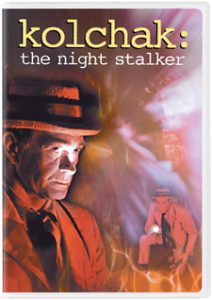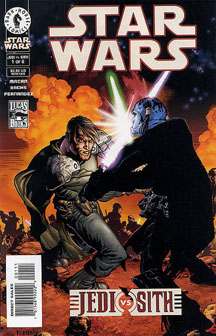“Jedi vs. Sith” (2001) is the second of three pieces to the puzzle that tell the story of arguably the most important pre-movie event on the “Star Wars” timeline: The end of the Sith (or so the Jedi think), leading Ki-Adi-Mundi to note in “Episode I” that “The Sith have been extinct for a millennium.” This crucial piece of “Star Wars” lore is also one of the neatest examples of the spontaneous creativity that can arise from a sprawling timeline.
The first telling of the Battle of Ruusan was in William C. Dietz’s illustrated novella “Dark Forces: Jedi Knight” (1998). Written before “Episode I” came out, Dietz didn’t know to call the bad guys “Sith” (he confusingly calls both sides “Jedi,” although he does use the terms “Brotherhood of Darkness” and “Army of Light”). Kyle Katarn (in a story set slightly after “Return of the Jedi”) experiences the events through dream-walking via a Jedi ghost named Tal, who fought for the Light during the battle.
The third telling came in Drew Karpyshyn’s novel “Darth Bane: Path of Destruction” (2006). After chronicling Bane’s formative years, the book retells the events of “Jedi vs. Sith” from Bane’s perspective, replacing that of cousins Tomcat, Bug and Rain, pre-teens or barely teenagers who had been recruited by the desperate Army of Light.
The six-issue “Jedi vs. Sith” drops Tal from the narrative for some reason, but expands the Battle of Ruusan into a war of attrition through various skirmishes. It culminates with increasingly nutso Brotherhood leader Lord Kaan exploding a thought bomb that captures the souls of most of the Jedi and Sith. (Those souls will be released by Katarn in “Dark Forces.”) Bane escapes, as does Rain (who becomes Bane’s apprentice Zannah), and Tomcat, who wanders into the desert. The bouncers, empathic round creatures that float in the air, carry over from “Dark Forces.”
Because the main characters are three (initially) innocent kids, “Jedi vs. Sith” is a powerful story about the horrors of war in the tradition of “Ender’s Game,” except that this one feels ancient rather than futuristic. Without much sense of how the world works, why wars happen, or even the moral difference between good and evil, Tomcat, Bug and Rain are plucked off of their crappy mudball of Somov Rit by ancient Jedi Master Torr.
“Jedi vs. Sith” is far and away my favorite Darko Macan story, as I found “Vader’s Quest” boring and “X-Wing Rogue Squadron: The Phantom Affair” better but still uneven. I think artist Ramon F. Bachs (along with inker Raul Fernandez and colorist Chris Blythe) deserves a lot of credit for that, as he also drew “Jango Fett: Open Seasons” (another masterwork of knitting together the continuity), which is the best work by Haden Blackman.
Bachs’ main trick is to draw the kids with big eyes and tear-stained faces, but darn it, it works. Indeed, the whole idea of Light vs. Dark works best with kids whose moral compasses are unformed and who can be easily manipulated. Often times when adults (Ulic Qel-Droma, Anakin Skywalker, Jacen Solo) decide to turn evil, I think, “Come on, you know better than that.” With kids, there’s a palpable sense of unavoidable tragedy. Tomcat’s enthusiasm about war is akin to the excitement about a soccer game for a kid in modern civilization.

Because of the medium, we can’t escape seeing kids on the battlefield and thinking they shouldn’t be there. Tomcat makes a couple new friends on the recruitment ship, then watches them get blown out of the sky. He kills an enemy, and sees it’s a fresh-faced girl about his own age. And ultimately, since this is a “Star Wars” story, the kids get various limbs sliced off in battle.
Every moment of death and destruction is a rude awakening for Tomcat and Bug, but Tomcat’s particular arrogance and sense of entitlement make him opt to join the Dark Side rather than destroy it. Readers, along with Bug, see Tomcat’s downfall and feel helpless to stop it. Rain’s is the most powerful story, because the naïve youngest cousin is just as empathic as the bouncers, but to a fault: When a good Jedi kills her bouncer out of necessity (the bouncers were spreading depression among his troops), Rain immediately kills him with the Force. She suspects it’s wrong, but admits to her new teacher, Bane, that she doesn’t fully understand the Dark Side because she’s “still young.”
I’ll likely get more insight into the other characters – as well as Bane’s instituting of the Rule of Two and training of his new apprentice, Zannah — when I get to my “Path of Destruction” re-read. But “Jedi vs. Sith” achieves what it intends to do: Make my heart break for Tomcat, Bug and Rain.

